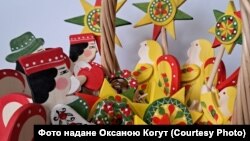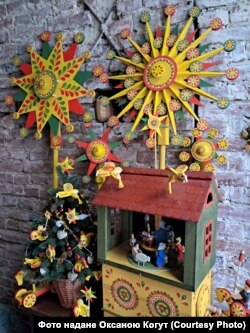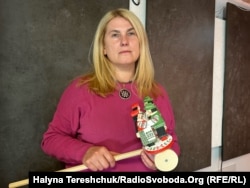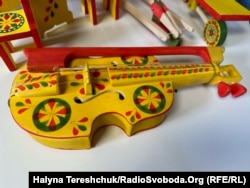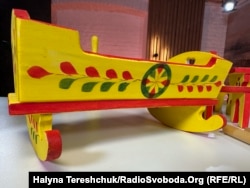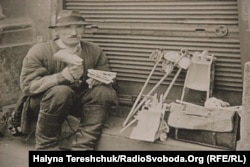LVIV -- Brightly colored, made of wood, and distinguished by their flat profile, Yavoriv toys have been created by craftsmen in western Ukraine's Carpathian Mountains since the 15th century.
This year, a nativity scene made in the traditional Yavoriv style is featured at an exhibition called 100 Nativity Scenes on St. Peter's Square in the Vatican. Though it is being presented for the first time, the rotating biblical figures, housed in a chest, were actually made eight years ago.
For its creators, Oksana Kohut and Ostap Soyka, having their works recognized and shown at the Vatican is part of a long process aimed at gaining visibility and recognition for a truly unique craft.
Kohut has been creating these toys for over 15 years. She feels that their popularity has room to grow, although keeping this art form alive in the modern world has proven problematic.
"A conference was held in Yavoriv, where they talked about this craft and its history, and that's a good thing. But talking is one thing," she said, before pointing out that her and Sovka's dream of having a museum where artisans can learn how to make the toys has yet to be realized.
"Our aim is to preserve this style and pass on the knowledge to produce them," Kohut said.
"It's a pity, because [creators] could pass on their knowledge to others, but more attention needs to be paid to them," she said.
At the beginning of the 20th century, there were nearly 100 families in the region of Ivano-Frankivsk, which borders Poland to its west, who created wooden figures in this folk style. Now there are just a handful of people.
"You have to live this work; you have to love it very much," Kohut said.
Traditional Yavoriv artisans, who would often sell their handmade wares in markets in Poland or Austria, could not do so during the Soviet-era. Though children still loved the toys, the number of people making them began to dwindle as their income from selling them declined.
When Kohut and Soyka began their search for inspiration in creating these pieces, they looked to collections exhibited at the Andriy Sheptytsky National Museum in Lviv. Sheptytsky's father Ivan, founded a toy-making school -- the State Woodworking School -- in Yavoriv in 1896. However, the school closed during the Second World War.
"We, in fact, made copies of those toys and continued for a long time, because our first task was to preserve and continue the tradition," Kohut said.
The two artisans make approximately 20 different types of decorations and now struggle to meet demand.
"People ask where they can buy the toys. There are photos, but there is no product. Many people would like to come, look, and buy, but I am not able to receive them," Kohut said.
For those who are able to find them -- mainly collectors from abroad and from Ukraine -- the costs of the toys have risen three to five times over the past few years due to various factors, such as the sourcing of the sycamore wood they are made from.
Poland also creates similar wooden toys called Yavorivska that closely resemble their Ukrainian counterparts. Their production in Lezajsk, in southeastern Poland, originates from a single craftsman who left Yavoriv to start his own workshop.
"If we do not create a cultural center, with a museum, a workshop where old toys will be collected, and new ones that are currently being made, then, of course, Poland could claim the Yavoriv toys brand," Kohut said.
Kohut, who grew up surrounded by artisans from Ivano-Frankivsk, said she was always attracted by the idea of working with her hands.
"Here, people like to create various things from wood. I grew up in that environment, surrounded by forests. I always gravitated toward wood. I remember seeing the first exhibition of Yavoriv toys, which was organized by masters from the school."
For Kohut, there is joy in creating toys with bird's wings that flap, furniture for dolls, grasshoppers, rattlesnakes, dancers, and anything else that would fire a child's imagination.
"Everything depends on the parents, how they teach the child, how they instill love for Ukrainian culture and art. And this should be done from childhood," she says.
Kohut also longs for the time when parents would pass down toys from one generation to the next.
"It is already a collector's item, a work of art," she says. "It cannot compete with the modern world of toys, but is that necessary when the Yavoriv toy is a work of art and a part of our culture?"




